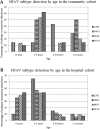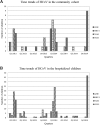Epidemiology and Clinical Features of Human Coronaviruses in the Pediatric Population
- PMID: 28482105
- PMCID: PMC5954244
- DOI: 10.1093/jpids/pix027
Epidemiology and Clinical Features of Human Coronaviruses in the Pediatric Population
Abstract
Background: The epidemiology and clinical features of human coronaviruses (HCoVs) in children are not fully characterized.
Methods: A retrospective study of children with HCoV detected by reverse-transcriptase polymerase chain reaction (RT-PCR) was performed for a community cohort and a children's hospital in the same community from January 2013 to December 2014. The RT-PCR assay detected HCoV 229E, HKU1, NL63, and OC43 in nasal swabs from symptomatic children ≤18 years. Factors associated with increased severity of illness in hospitalized children were assessed by multivariable logistic regression.
Results: Human coronavirus was detected in 261 children, 49 and 212 from the community and hospital, respectively. The distribution of HCoV types and seasonal trends were similar in the community and hospital. Community cases were older than hospitalized cases (median age, 4.4 versus 1.7 years, respectively; P < .01), and a minority of community cases (26.5%) sought medical attention. Among the hospitalized children with HCoV detected, 39 (18.4%) received respiratory support and 24 (11.3%) were admitted to the pediatric intensive care unit (PICU). Age <2 years (odds ratio [OR] = 5.0; 95% confidence interval [CI], 1.9-13.1) and cardiovascular (OR = 3.9; 95% CI, 1.6-9.5), genetic/congenital (OR = 2.8; 95% CI, 1.1-7.0), and respiratory chronic complex conditions ([CCCs] OR = 4.5; 95% CI, 1.7-12.0) were associated with receiving respiratory support. Genetic/congenital (OR = 2.8; 95% CI, 1.1-7.4) CCCs were associated with PICU admission. Severity of illness was similar among hospitalized children with different HCoV types.
Conclusions: Children in the community with HCoV detected generally had mild illness as demonstrated by few medically attended cases. In hospitalized children, young age and CCCs, but not HCoV type, were associated with increased severity of illness.
Figures



References
MeSH terms
Grants and funding
LinkOut - more resources
Full Text Sources
Other Literature Sources

